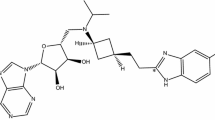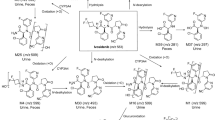Abstract
Objective: This study investigated the pharmacokinetics of the catechol-O-methyltransferase (COMT) inhibitor entacapone by giving simultaneously stable non-radioactive isotope 13C-entacapone intravenously (i.v.) and unlabelled entacapone orally. In comparison with a crossover design, the simultaneous i.v. and oral administration made it possible to minimise intra-individual variation, sample size and the duration of the study and still obtain accurate pharmacokinetic data. Methods: Eight healthy male volunteers were enrolled in this study. They were given a 20-mg i.v. dose of 13C-entacapone as a 1-mg/ml infusion at a constant rate of 5 mg/min over 4 min and a 100-mg dose of unlabelled entacapone orally immediately after the infusion. Blood samples were drawn at –5 (before onset of infusion), 0 (upon termination of infusion), 2, 5, 10, 20, 30 and 45 min and 1, 1.5, 2, 3, 4, 5, 6, 7, 8, 10 and 12 h after the tablet ingestion. Urine during the 48 h after dosing was collected in fractions. Concentrations of 13C-entacapone and entacapone in plasma samples and urine fractions were determined using gas chromatography–mass spectrometry. Results: The decay of i.v. 13C-entacapone in plasma was tri-exponential and its pharmacokinetics were described using an open three-compartment model. The volume of the central compartment (Vc) and the volume of distribution at steady state (Vss) were 0.08±0.03 l/kg and 0.27±0.10 l/kg, respectively. Total plasma clearance (Cltot) averaged 11.7±1.9 ml/min kg–1. The half-lives for the distribution phase and for the rapid and terminal elimination phases (t 1/2 α, t 1/2 β and t 1/2 γ) were 0.05±0.01 h, 0.38±0.16 h and 2.40±1.70 h, respectively. The terminal elimination phase accounted for only 9% of the total area under the plasma concentration–time curve (AUC), which was 409±98 ng h/ml after the i.v. dose. Oral entacapone was absorbed rapidly with a time to reach the peak concentration (tmax) of 0.9±0.4 h, a maximum concentration (Cmax) of 457±334 ng/ml and an AUC of 497±118 ng h/ml. During the 48 h after dosing, the recovery of free and conjugated unchanged 13C-entacapone in urine was 38.1±7.2% of the i.v. dose and the recovery of free and conjugated unchanged entacapone 13.3±3.9% of the oral dose. The bioavailability of oral entacapone was 25% based on the AUC values and 35% based on urinary excretion. Conclusion: The results of the present study using stable isotope technique indicate that entacapone is rapidly absorbed, distributed to a small volume and rapidly eliminated by mainly non-renal routes. The pharmacokinetic profile of entacapone provides the rationale for a concomitant and frequently repeated simultaneous dosing of entacapone with levodopa and dopa decarboxylase inhibitors in the treatment of Parkinson's disease. This study confirmed the previously published data and fully support the validity of the technique used.
Similar content being viewed by others
Author information
Authors and Affiliations
Additional information
Accepted in revised form: 30 October 2000
Electronic Publication
Rights and permissions
About this article
Cite this article
Heikkinen, H., Saraheimo, M., Antila, S. et al. Pharmacokinetics of entacapone, a peripherally acting catechol-O-methyltransferase inhibitor, in man. Eur J Clin Pharmacol 56, 821–826 (2001). https://doi.org/10.1007/s002280000244
Received:
Published:
Issue Date:
DOI: https://doi.org/10.1007/s002280000244




